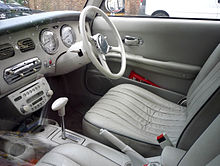| Nissan Figaro (E-FK10) | |
|---|---|
 Nissan Figaro finished in Pale Aqua (summer). | |
| Overview | |
| Manufacturer | Nissan |
| Production | 1991[1] 20,073 produced |
| Assembly | Oppama Plant, Yokosuka, Kanagawa, Japan |
| Designer | Naoki Sakai and Shoji Takahashi |
| Body and chassis | |
| Class | City car |
| Body style | 2-door fixed-profile convertible |
| Layout | FF layout |
| Related | |
| Powertrain | |
| Engine | 987 cc MA10ET turbo I4 |
| Transmission | 3-speed automatic |
| Dimensions | |
| Wheelbase | 2,300 mm (90.6 in) |
| Length | 3,740 mm (147.2 in) |
| Width | 1,630 mm (64.2 in) |
| Height | 1,365 mm (53.7 in) |
| Curb weight | 810 kg (1,790 lb) |


The Nissan Figaro is a two-door car manufactured by Nissan in 1991 for the Japanese market. Based on the original Nissan March/Micra, the Figaro is a fixed-profile convertible with a 2+2 seating arrangement. It shares the March's front-engine, front-wheel-drive layout. When new, it was sold only through Nissan Cherry Stores.
A total of 20,073 Figaros were produced by Nissan in the convertible's single year of series production,[2] all with right-hand drive;[3] at least several thousand have been grey imported to Great Britain and Ireland.[4][5] There are a few examples of left-hand drive conversions for countries that have right-hand traffic.[6][7]
Because of its origins at Pike Factory, Nissan's special project group, the Figaro (along with the Nissan Pao, Be-1, and S-Cargo) is one of Nissan's "Pike cars," and represented a design strategy that adapted "design and marketing strategies from other industries like personal electronics".[8]
In 2011, design critic Phil Patton, writing for the New York Times, called the Pike cars "the height of postmodernism"[8] and "unabashedly retro, promiscuously combining elements of the Citroën 2CV, Renault 4, Mini, and Fiat 500".[8]
- ^ Saarinen, Martin (6 July 2016). "Cult classic: celebrating 25 years of the Nissan Figaro". Auto Express. Retrieved 3 November 2023.
- ^ Dodd, Mark (April 15, 2017). "Nissan Figaro FK10 VIN Table". GTR-Registry.com. Retrieved November 24, 2019.
- ^ Baime, A.J. (April 19, 2016). "How a Nissan Figaro Became an Instant Classic in the U.S." The Wall Street Journal. Retrieved November 17, 2019.
- ^ "Nissan Figaro at 30: plotting the retro roadster's history". Autocar. Retrieved 2023-08-29.
- ^ "Buying a used Nissan Figaro". The Irish Times. Retrieved 2023-08-29.
- ^ McAleer, Brendan (2021-08-23). "This left-hand-drive Figaro proves nothing is impossible". Hagerty Media. Retrieved 2022-07-04.
- ^ "LHD – A look a left hand drive Nissan Figaros - LHD – A look a left hand drive Nissan Figaros - Figaro Owners Club". Retrieved 2022-07-04.
- ^ a b c Patton, Phil (March 18, 2011). "Nissan's Cartoon Cars, Once So Hip". The New York Times. Archived from the original on 2013-01-23.